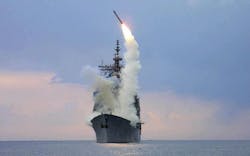Navy asks Raytheon for multi-sensor anti-ship guidance to enable Tomahawk missiles to hit targets at sea
PATUXENT RIVER NAS, Md. – U.S. Navy guided missile experts are asking Raytheon Technologies Corp. (RTX) to provide missile seeker upgrade kits to enable BGM-109 Tomahawk cruise missiles to hit moving ships at sea.
Officials of the Naval Air Systems Command at Patuxent River Naval Air Station, Md., have announced a $124.3 million order to the RTX Raytheon segment in Tucson, Ariz., to build Maritime Strike Tomahawk (MST) sensor seekers to provide midcourse and terminal guidance to the Tomahawk in attacks on enemy ships from Navy surface warships and submarines.
The Maritime Strike Tomahawk, also called Tomahawk Block 5A, was introduced in 2021 with improvements to navigation and multi-sensor in-flight targeting that give the long-range subsonic weapon anti-ship missile capability. The missile fires from Navy surface warships and submerged submarines.
The seeker suites will be installed in recertified Tomahawk missiles for the Navy. The maritime-strike Tomahawk Block-5A has updated seeker technology and sensor-processing capabilities to enable the missile to hit moving targets at sea.
Navy joint task force commanders increasingly face long-range anti-ship missiles that threaten their surface forces and potentially deny access to mission-critical areas of operation, so they need a near-term capability to counter hostile surface forces. Without this, the Navy could face loss of life or critical mission failure, Navy officials say.
The Maritime Strike Tomahawk will augment the newer and more sophisticated U.S. Navy and Air Force AGM-158C Long-Range Anti-Ship Missile (LRASM) that can launch from the Navy F/A-18E/F Super Hornet jet fighter bomber, as well as from the Air Force B-1B Lancer long-range strategic bomber.
LRASM also is being considered for launch from the F-35 Lighting II joint strike fighter, the P-8A Poseidon maritime patrol jet, as well as from the Navy Mark 41 shipboard Vertical Launch System and for submarine launchers.
The LRASM travels at high subsonic speeds, and for some future uses likely will give way in the future to expected new generations of hypersonic missiles. Submarine-launched versions are under consideration.
For the Maritime Strike Tomahawk, Raytheon can integrate a new multi-sensor suite into the Tomahawk missile that consists of a new seeker, processor, software, and a new inertial measurement unit for terminal maneuvers, as well as redesigned power budget and system cooling.
On this order Raytheon will do the work in Boulder, Colo.; Tucson, Ariz.; North Logan, Utah; Dallas; Pontiac, Mich.; Huntsville and Berryville, Ark.; Minneapolis; Elyria, Ohio; and other U.S. locations, and should be finished by November 2025. For more information contact RTX Raytheon online at www.rtx.com/raytheon, or Naval Air Systems Command at www.navair.navy.mil.
About the Author
John Keller
Editor-in-Chief
John Keller is the Editor-in-Chief, Military & Aerospace Electronics Magazine--provides extensive coverage and analysis of enabling electronics and optoelectronic technologies in military, space and commercial aviation applications. John has been a member of the Military & Aerospace Electronics staff since 1989 and chief editor since 1995.
